This review is my subjective impression as a delighted new owner of an evolving audio classic, the Legacy Focus SE ($10,600/pr). A large floor standing loudspeaker, the Focus SE has won numerous awards and been widely reviewed positively, including in Dagogo, 2008. The Focus SE, like its better-known sibling Aeris, is compatible with Legacy’s Wavelet advanced room correction DSP (examined in-depth for Dagogo by Doug Schroeder in his recent review of the $50,000.00 Legacy V system).
Like any complex and refined component, there’s an extended break-in period for the Legacy Focus SE. Mine didn’t sound right at all until at least a week of continuous use, progressing to sounding very good after a few weeks, and I expect break-in to continue in subtle ways for months, especially given the quality and quantity of mechanical and electrical components, driver suspensions, crossover and internal wiring.
UPS delivered two crates totaling 390 pounds only as far as the pallet onto which they were strapped could travel. I recommend having a strong friend or two on hand, three if your back is bad, for the scheduled delivery. (UPS was 90 minutes late, after the four-hour window.) Once in place, the Focus SE is exceptionally easy to move and adjust. The height-adjustable feet may be unthreaded for replacement or adjustment and the speaker stands stably on three footers. The robust, finely machined bi-wire capable binding posts sit a full 8 inches or so from the floor.
Breathing room is crucial: at least 3 feet of distance from the front and side walls is essential, any less tends to bloat the bass or interfere with dispersion in my room. My listening room is barely large enough, though it’s my expectation that Legacy’s Wavelet DSP will moot the serious remaining issues.
Legacy Aeris at Half the Price
According to Legacy, the Focus SE’s performance envelope is very close to its sibling, the Aeris. Coupled with the Wavelet capability, the Focus SE is a “poor man’s Aeris” for about half the price. It was the Aeris and its companion DSP room compensation that first drew my attention to Legacy. The Wavelet DSP occupies a strong position in the growing category of D/A-capable preamplifiers, or in this case, Room Correction Processor and D/A with line level preamp that stands out for its advanced Bohmer DSP, completeness and value.
My less-than-perfect listening room remains a challenge after all these years. I’ve recently added Shakti Hallographs and active room conditioners from Bybee and Acoustic Revive to my listening room. Each made striking improvements, yet there remain chronic challenges to bass and dispersion. Therefore, the Focus SE’s Wavelet capability is a significant factor in my purchase decision, a product I hope will mitigate the remaining imbalances and room signature when I mate the speaker with the Legacy DSP in the near future.
With sensitivity above 95 dB, the Legacy Focus SE is very easy to drive yet is specified to be able to accommodate up to 700 watts. I’ve gotten excellent results with 30-watt tube monoblocks, but can tell the speakers will play cleanly and considerably louder with more power.
The Legacy Focus SE’s reproduction of symphonic strings is exceptionally good, thanks in no small part to their superb execution of the Air Motion Transformer (or Transducer) technology. AMT was invented and patented by Oskar Heil, the driver is a folded planar bellows operating in an intense magnetic field, resulting in a large surface area, quick acceleration and high efficiency.
I first heard the legendary Heil AMT-1 at a hi-fi show in 1975, then bought and owned a pair until 1988. Over subsequent decades and several generations, AMT has emerged as a viable alternative to conventional piston speaker technology.
Legacy founder and designer, Bill Dudleston has further advanced the AMT design with updated materials and testing, culminating in very possibly the finest implementation of the technology yet. The midrange consists of sixteen square inches of folded Kapton operating in an extremely high (2 tesla) magnetic field. The combined high frequency and midrange AMT drivers blend seamlessly with the flanking 7-inch dynamic “midwoofers” and pair of twelve-inch bass units.
The ensemble opens a window onto performance not unlike the legendary Apogee Duetta panel/ribbons, though with greater focus and a wider sweet spot. Legacy’s elegant AMT offers a natural and lifelike presentation of violin, viola, cello and double bass, depicting string ensembles with notable relaxation, naturalness and extension, balancing string attack, body resonance and massed bloom.
The speakers’ presentation of string orchestras recorded in highly resonant space is a special delight. Lately, I’ve been enjoying the Nimbus Records 1988 cycle of Felix Mendelssohn String Symphonies performed by the English String Orchestra conducted by William Boughton (Nimbus 5141-5143). The Focus SE responds well to the proprietary Nimbus “ambisonic” recording technique that highlights the recording space itself. Their venue, the Great Hall of Birmingham University, is a virtual cathedral of wood sustaining a lush bloom. Yet, there’s palpable presence to the cellos and basses.
Felix Mendelssohn composed over a dozen charming “sinfonias” for strings between the ages 11 and 15 years. Tunefully melodic with classical equipoise, they contain many familiar melodies and signature devices heard in his later symphonic and chamber works. Suppressed by a more mature Mendelssohn, mid-20th Century scholarship unearthed them after 150 years.
Hyperion, BIS and Fleur de Lys labels have also recorded the Mendelssohn string symphonies, but those productions lack the bloom, good charm and bonhomie of Boughton and the ESO. Notably, Hyperion’s otherwise delightful cycle is badly marred by the rumble of low frequency sound pollution from local English traffic.
The Legacy/Nimbus synergy continues in other titles reproducing the convincing thrum of plucked cellos and basses in the “Playful Pizzicato” movement of Benjamin Britten’s Simple Symphony (Nimbus 5025). Likewise for string serenades and suites on Nimbus by Arensky, Bartok, Dvorak, Elgar, Respighi, Tchaikovsky and Walton.
The Focus SE is equally impressive with string-oriented genres like chamber music, Hot Club jazz or Country fiddle, balancing the bite of string attack against mellow glow of body resonance. Naturally, flaws of recordings that are too hard, too closely-miked or steely are revealed, though with less discomfort than with other speakers
Other String Vectors
From another vector altogether comes electro-acoustic violinist Laurie Anderson’s remarkable, Life on a String (Nonesuch, 2001). Several tracks are startling audio demonstration pieces, and the Focus SE vividly projects her brutalist opus, “My Compensation.” Phased sonic energy rockets around the room, the floor shivering with some of the deepest synth bass in my collection.
Clearing the palette is the whimsical “Dark Angel,” which might as well be by another artist altogether. It’s a clever conversational Anderson confection in the Michel Legrand Umbrellas of Cherbourg mode. The focal point is a close-miked string section overlaid by clever production and panning effects. With aplomb, the Focus SE serves up clear, colorful detail and nuance, negotiating dense textures deftly while delivering walloping dynamics.
Legacy Professionalism and American Craftsmanship
Since the 1970s I’ve owned a series floor-standing speakers that had at least some relation to the state of the art in loudspeaker performance or technology. Legacy Focus SE sums up some of their best qualities:
- The speed of the original Heil AMT (Air Motion Transformer).
- See-through holography and slamming dynamics of Apogee’s panel/ribbon .
- Triangle’s seductive midrange and the room-filling fun of Dahlquist and,
- The finely honed precision and balanced dynamics of its immediate predecessor in my system, Audio Physic Virgo 25.
To these virtues, Legacy adds refined harmonic fidelity, a larger, deeper and more convincing sound stage, fatigue- and stress-free highs, vast dynamic authority and exceptionally well-integrated bass.
The Legacy Focus SE loudspeaker is elegant, robust, and aesthetically agreeable. I usually prefer listening with cosmetic speaker baffles removed, but for once they don’t impose a tax on performance and I find them handsome, although many will prefer exposing the sexy high tech edge of the front baffles.
Doing business with Legacy was a pleasure. They were completely professional in all respects from demo to delivery. Have you ever had a legitimate offer so good you almost broke a wrist reaching for your wallet? Legacy products are a stupendous American-built value that could easily be marketed and sold for two or three times the price, with very generous upgrade/trade-in policies within the Legacy line.
Given a do-over I would purchase the powered Focus XD model, each cabinet hosting 750 watts of on-board power for either bass or full range amplification. However, Legacy offers a very tempting upgrade path (less than $2,000) to the powered XD version from the basic SE.
- (Page 1 of 1)

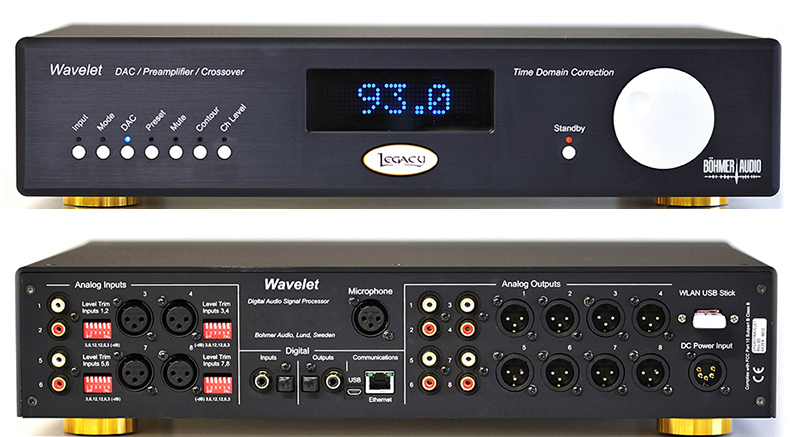
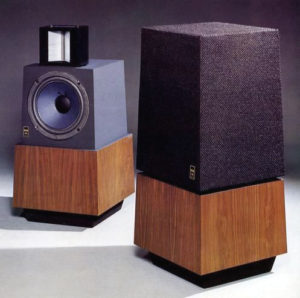
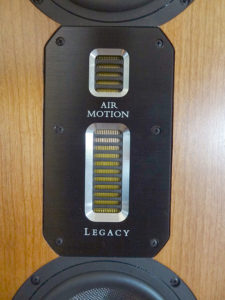
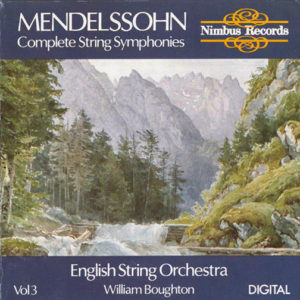
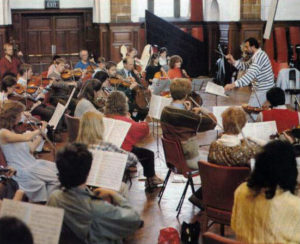
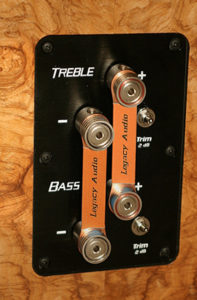

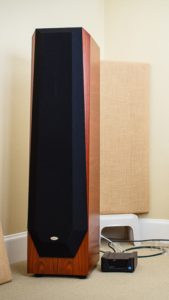
“the Focus SE is exceptionally easy to move …”
I would like to know more. They weigh 125 Lbs. Does it slide easy? How would it be “easy” to pick up and move such a speaker?
Gary —
The well-designed footers slide easily on a rug. Center of gravity is low.
(Incidentally, Legacy has published various weight figures. They are closer to 175 pounds out of their cartons.)
Dave
As a fellow Legacy Audio FOCUS SE owner, I agree with your description. They are remarkable and can be made to work in smaller rooms with judicious application of room treatment and DSP. I have not had a chance to evaluate the Wavelet processor, but Acourate from AudioVero does a great job of reigning in the bass. I considered a number of DSP solutions, but if Acourate is good enough for Bob Katz, it’s good enough for me. 🙂
My brother in law owns a pair of much older Focus, and I’ve had a chance to audition numerous legacy gear. To be honest every >$5,000 Legacy product I’ve listened to has been hard sounding on the upper end lacking any grace or ‘air’. The Focus like most of Bill Ds big designs are incredibly detailed dynamic wise, but exaggerating every defect in a recording doesnt make a good speaker. I do hope these latest Focus lack the harsh and blatant sibilence of his older versions. For the price they should. Personally I’ll stick to speakers that vanish vs broadcast how expensive they are.
Somehow what you feel you are hearing from the Focus is not realized by any professional audio reviewer, bar none. They reveal what is on the recording. Maybe your choices of your musical format is lacking in quality as no one finds much to fault with the Focus, especially at their price point. Possibly your amps, preamp, and front end is in question. I have found that even low quality audio products sound great on Legacy products.
I have a pair of the legacy convergence speakers they are around 27 years old and i paid 3,250 dollars for them.They sound as good to me as the day i got them.There much like the original focus speakers they have two 12 inch woofers two 7 inch midrange drivers and one titanium dome twitter and one rear firing titanium twitter they have three toggle switchers to contour the sound.they can be bi wired.I love these speakers.I am thinking about getting the focus se for me thats quiet a lot of money as they say you only live once.
Since knowing Bill Duddelston since the early 1980’s and purchased a pair of Rosewood Whispers in 1995, I have never heard a speaker called “Convergience “. Please advise and expand on their performance Thanks.
These speakers sound great and are beautifully crafted. Bill Dudleston is, by now, an accomplished speaker designer/builder, and his products seem to have a great following. He will tell you that he has learned a great deal from the famous speaker designers and engineers from past years and put the best of it to work on his designs, and this is evident in the results. I wish, however, that the speakers were designed more scientifically; i.e., with driver integration and acoustic performance done in an anechoic chamber for measured response and distortion rather than by being “voiced.” An already fine speaker could potentially be made even better!